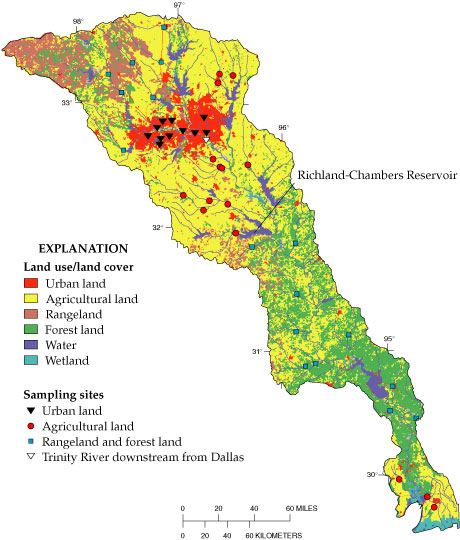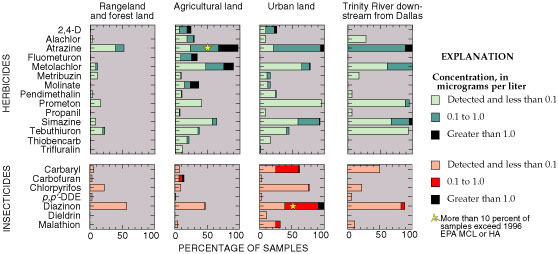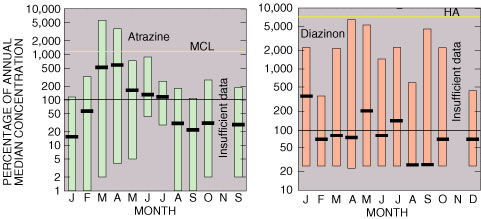


Pesticide sampling sites on streams of the Trinity River Basin during 1993-95. The greatest density of sites is in agricultural and urban areas.
Pesticides (herbicides, insecticides, and fungicides) are present in streams throughout the basin (Shipp, 1995b; Ulery and Brown, 1995). Herbicides are used to control nuisance plants. In agricultural areas, they commonly are applied to the soil in late winter or early spring and during the growing season to improve crop yields and quality. In urban areas, they are used to control weeds in lawns and unwanted vegetation along streets and highways to improve safety and reduce maintenance. Insecticides are used to control insects that might damage crops, landscaping, and buildings or cause disease in humans and animals. Modern insecticides are designed to decompose into less harmful products faster than many older insecticides. Fungicides are used to control plants such as molds and mildews. Even though pesticides are very useful, they can be harmful to humans, domestic animals and wildlife, desirable plants and insects, and whole ecosystems.
In most streams of the Trinity Basin, herbicides are more prevalent than insecticides—the number of herbicide detections was greater than the number of insecticide detections. The most commonly detected herbicide in 284 samples collected from March 1993 to September 1995 is atrazine. Atrazine typically is used on fields of corn, hay, and sorghum and on lawns. Atrazine was detected in about one-half the 38 samples from 17 rangeland and forest stream sites, in more than 95 percent of the 148 samples from 15 agricultural stream sites, in all 75 samples from 11 urban stream sites, and in all 16 samples from a site on the Trinity River downstream from Dallas. The EPA 1996 MCL for atrazine is 3.0 micrograms per liter. Generally, the agricultural stream samples had larger atrazine concentrations than samples from rangeland and forest streams, urban streams, or the Trinity River downstream from Dallas. About 12 percent of the agricultural stream samples had atrazine concentrations greater than the MCL; none of the samples from rangeland and forest streams, urban streams, and the Trinity River downstream from Dallas had atrazine concentrations greater than the MCL.
Atrazine concentrations show a seasonal pattern. Concentrations tend to rise to seasonal highs in the spring and then decline to seasonal lows that last from late summer through midwinter (Land and Brown, 1996). The median atrazine concentration among all samples was 0.26 microgram per liter. The highest monthly median concentration, in April, was about 70 percent of the MCL for atrazine; monthly median concentrations from late summer to midwinter were less than one-tenth of the April median concentration.
The most commonly detected insecticide in the 277 samples was diazinon. Diazinon generally is applied to lawns, gardens, and landscaped areas. Diazinon was detected in about one-half of the rangeland and forest samples and agricultural samples, in all the urban samples, and in about 90 percent of the Trinity River downstream from Dallas samples. The EPA 1996 lifetime health advisory (HA) (the concentration in drinking water that is not expected to cause any adverse noncarcinogenic effects over a lifetime of exposure) for diazinon is 0.6 microgram per liter. Generally, diazinon concentrations are larger in urban stream samples than in stream samples from other settings. About 15 percent of the diazinon concentrations in the urban streams exceeded the HA.

Distributions of selected herbicides and pesticides in streams of the Trinity River Basin during 1993-95 are related to land-use practices.
Diazinon concentrations do not show a distinct seasonal pattern. The median diazinon concentration among all samples was 0.008 microgram per liter. None of the monthly median concentrations exceeded the HA for diazinon.
Pesticides other than atrazine and diazinon also are commonly detected in basin streams. Twenty-three different herbicides were detected in rangeland and forest streams, 19 in agricultural streams, and 24 in urban streams. Among herbicides other than atrazine, prometon was detected in almost 40 percent of the agricultural stream samples and in more than 90 percent of the urban stream samples at concentrations well below its 1996 EPA HA of 100 micrograms per liter. Metolachlor and simazine were detected in more than one-half the samples from agricultural and urban streams and from the Trinity River downstream from Dallas, each at concentrations below its respective 1996 EPA HA (for metolachlor) and MCL (for simazine).
Five different insecticides were detected in rangeland and forest streams, 10 in agricultural streams, and 10 in urban streams. Among insecticides other than diazinon, carbaryl and chlorpyrifos were detected in slightly more than 60 percent of the urban tributary stream samples, each of those compounds at concentrations below its respective 1996 EPA HA.
Although the concentrations of individual pesticides in most samples were less than EPA MCLs and HAs, some concerns remain. One involves pesticide concentrations in reservoirs: In the Trinity River Basin, nearly all streamflow is captured by reservoirs, many of which provide drinking water to urban areas. Pesticide concentrations in reservoirs could be greater than average concentrations in inflowing streams because much of the annual inflow to reservoirs occurs in the spring when runoff and pesticide use are greatest. For example, five samples from Richland-Chambers Reservoir collected in 1995 contained from six to eight pesticides each, and the three samples collected in June, after spring runoff, had atrazine concentrations of about 3 micrograms per liter (Land, 1997). Another concern involving pesticides in drinking water is that there is a lack of understanding of the toxicity of combinations of pesticides. Current EPA MCLs and HAs are only for individual compounds.

Seasonality of atrazine and diazinon concentrations in streams of the Trinity River Basin during 1993-95 reflects the timing of applications and runoff. Each bar shows the range between the 10th and 90th percentiles. The black line in each bar shows the monthly median concentration as a percentage of the annual median.
| AccessibilityFOIAPrivacyPolicies and Notices | |
 |
|